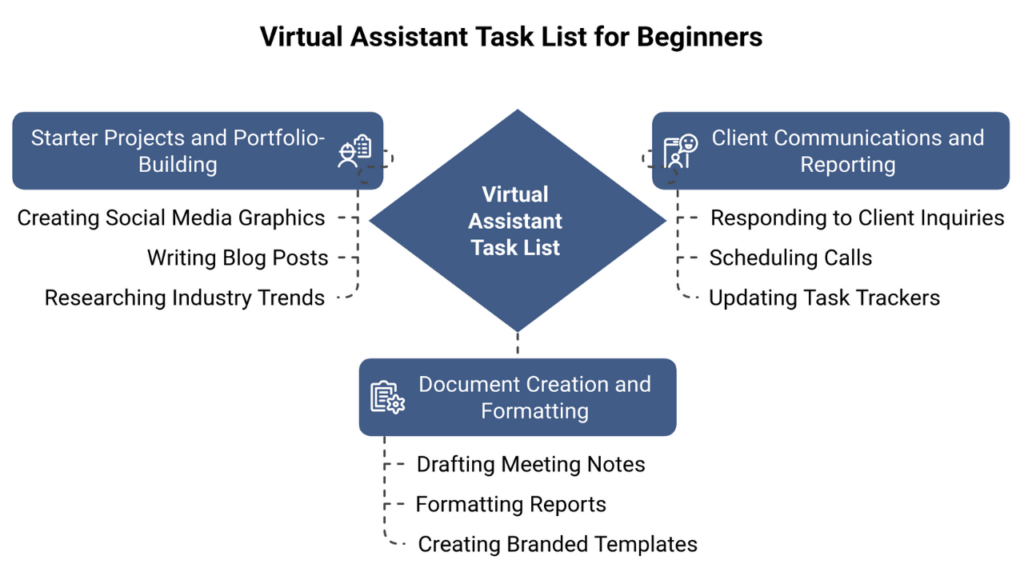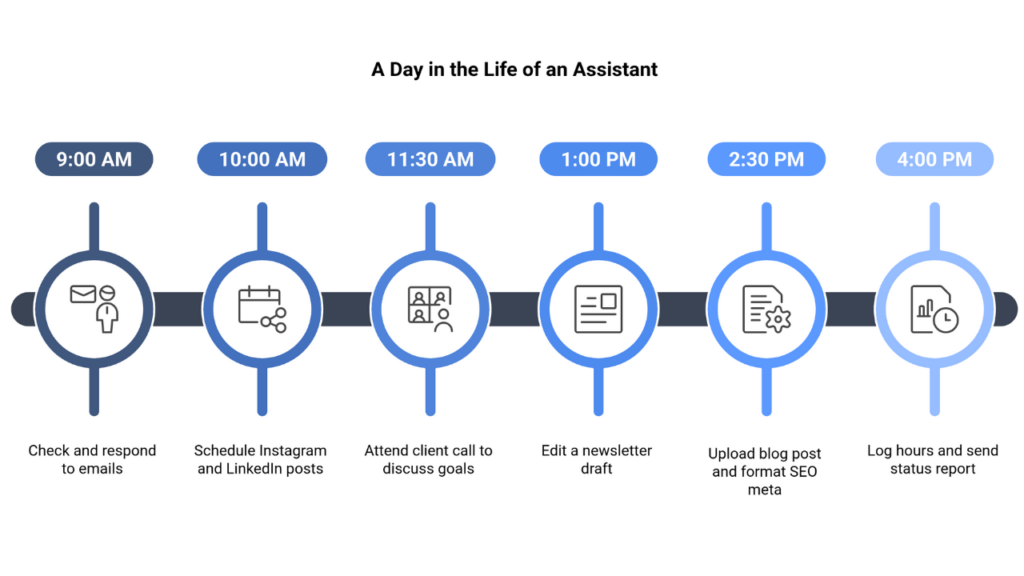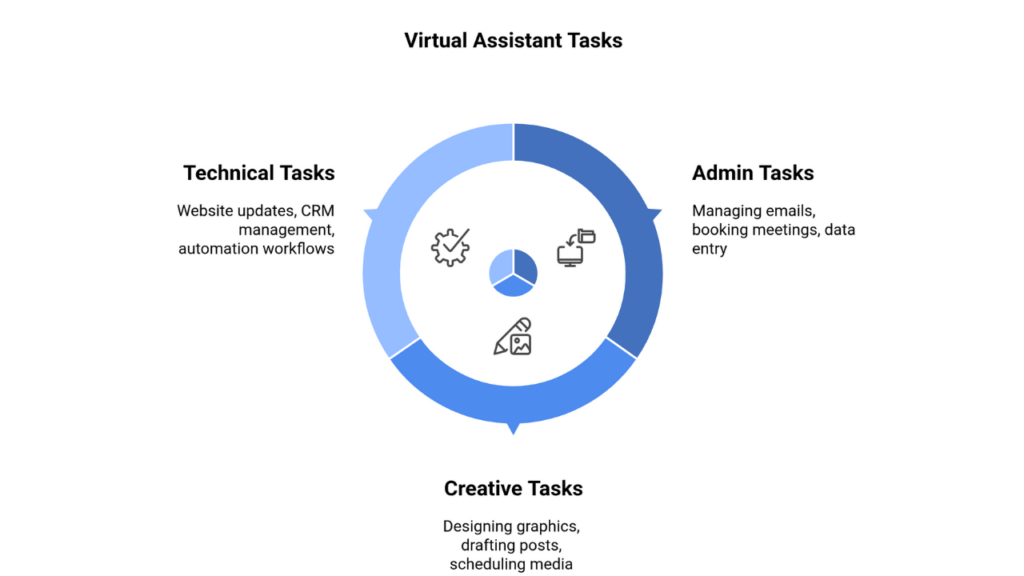What It’s Like to Work as a Virtual Assistant: A Day in the Life

Thinking about becoming a virtual assistant but not sure what the job really involves? Virtual assisting is a fast-growing, flexible career path ideal for those who want to work remotely without a rigid 9-to-5 schedule.
From managing emails and calendars to handling social media and content updates, virtual assistants juggle a wide range of daily tasks across industries.
According to the U.S. Bureau of Labor Statistics, employment for secretaries and administrative assistants is projected to grow by 1% from 2023 to 2033. While growth is modest, about 367,500 job openings are expected annually, mainly to replace workers retiring or changing careers.
If you’re considering a flexible remote career, understanding the daily life and tasks of a virtual assistant can help you decide if it’s the right path. Let’s dive in.
What Does the Life of a Virtual Assistant Look Like?
The life of a virtual assistant is centered around flexibility, variety, and the ability to work from virtually anywhere. As businesses increasingly shift online, virtual assistants (VAs) have become vital for helping manage daily operations, communication, and digital tasks.
Remote Work Flexibility
Virtual assistants enjoy the freedom to work from home or any location with a stable internet connection. This flexibility is ideal for those balancing other commitments or seeking better work-life alignment. Many VAs choose their own hours and client load, adapting the role to different lifestyles.
Multitasking Across Projects
A typical VA manages several tasks or clients at once. They might start their day scheduling meetings, spend midday updating social media or websites, and finish with inbox clean-up or invoicing. Being organized and efficient is key to handling virtual assistant tasks everyday.
Why Virtual Assistants Are in Demand
From startups to established companies, businesses rely on VAs to reduce overhead and improve productivity. Delegating recurring tasks—like email management, research, and data entry—frees up time for business owners to focus on growth. The growing demand for virtual assistant jobs reflects this shift toward remote and scalable support.
Virtual Assistant Tasks Every Day
Virtual assistants play a crucial role in keeping businesses organized and running smoothly. Their daily workload can range from simple administrative duties to more complex creative or technical tasks, depending on their skills and the needs of the client.
Common Daily Responsibilities
Here are some of the most common virtual assistant tasks every day:
- Managing inboxes and calendars – Sorting emails, responding to client queries, setting up meetings, and sending reminders
- Social media content scheduling – Planning and posting on platforms like Instagram, Facebook, or LinkedIn using scheduling tools
- Content formatting and updates – Uploading blog posts, formatting documents, and ensuring brand consistency
- Light design work – Creating basic graphics or branded visuals using tools like Canva
- Research and data entry – Gathering information for reports, organizing spreadsheets, and maintaining records
- Tracking progress – Updating status reports or timesheets to ensure transparency with clients
These daily responsibilities allow VAs to provide consistent, value-driven support while keeping operations efficient.
Tools for Managing Daily Virtual Assistant Tasks
To streamline their work, virtual assistants rely on a variety of digital tools that help them stay organized and productive. Some of the most commonly used tools include:
- Trello – Task and project management through boards and checklists
- Google Workspace – Collaboration via Docs, Sheets, Calendar, Gmail, and Drive
- Canva – Easy-to-use design platform for social media, presentations, and marketing materials
- Zoom – Virtual meetings, client calls, and remote check-ins
- Buffer – Social media scheduling and analytics to manage multiple platforms
These tools make it easier for VAs to manage tasks efficiently—especially when working with multiple clients or fast-paced projects.
Things a Virtual Assistant Can Do for Businesses and Individuals
Virtual assistants offer wide-ranging support to both business clients and individuals. Whether it’s managing a growing company’s daily operations or helping an executive stay organized, a skilled VA can handle a variety of responsibilities.
What a Virtual Assistant Can Do
Virtual assistants (VAs) play a pivotal role in enhancing productivity by handling time-consuming tasks, allowing clients to concentrate on strategic initiatives.
The demand for VAs is on the rise; in 2024, the U.S. market for AI-powered virtual assistants was valued at approximately $3.8 billion, reflecting their growing significance in various industries.
| Task Type | Examples of What a Virtual Assistant Can Do |
| Administrative | Email management, scheduling, file organization |
| Marketing Support | Social media content creation, email newsletters |
| Website Assistance | Blog uploads, minor updates, plugin checks |
| Research & Data | Competitor analysis, product sourcing, data entry |
These services are often customized based on client goals and the VA’s skillset, and they form the foundation of virtual assistant jobs across many industries.
Virtual Assistant Personal Tasks
In addition to business support, many VAs also provide virtual assistant personal tasks for busy professionals. These tasks help clients stay organized in their personal lives and maintain productivity.
Here are some common personal support services:
- Booking appointments – Doctors, events, client calls, travel reservations
- Online purchases or gift sourcing – Shopping assistance for holidays or corporate gifting
- Calendar management – Keeping both business and personal schedules in sync
Offering personal support can increase a VA’s value and help build stronger, long-term client relationships.
Sample Virtual Assistant Task List for Beginners
Starting as a virtual assistant doesn’t require years of experience, but it does require being organized, reliable, and willing to learn. Many new VAs begin with foundational tasks that build confidence, develop client trust, and help create a strong portfolio.
Here’s a beginner-friendly virtual assistant task list that’s commonly assigned in the early stages:
Virtual Gurus Jobs & Top Platforms to Find Work
Searching for virtual assistant opportunities in the United States? While niche freelancing sites have their place, many job seekers turn to well-established employment platforms that offer a broad spectrum of remote and part-time positions. These platforms provide access to a diverse range of industries, from startups to large corporations, all seeking skilled virtual assistants.
According to the U.S. Bureau of Labor Statistics, office and administrative support occupations were the largest occupational group in May 2023, comprising approximately 18.5 million jobs and accounting for 12.2% of total U.S. employment.
What Is the Best Site for Virtual Assistant Jobs?
These platforms are widely recognized and utilized across the U.S., making them excellent starting points for finding virtual assistant opportunities that align with your skills and career goals.
How Much Do Virtual Assistant Jobs Pay?
Virtual assistant roles offer flexible earning potential, influenced by factors such as skill set, experience, and service structure. While specific data for virtual assistants isn’t separately categorized by the U.S. Bureau of Labor Statistics (BLS), we can reference related occupations for context.
According to the BLS, the median annual wage for secretaries and administrative assistants was $47,460 in May 2024, equating to approximately $22.82 per hour. It’s important to note that virtual assistants, especially those offering specialized services or operating as freelancers, may set rates that differ from traditional administrative roles.
Factors That Impact VA Earnings
Your income as a virtual assistant can vary widely depending on several key factors:
- Hourly vs. Project-Based Pricing
Beginners often start with hourly rates, but many VAs transition to flat-rate packages for recurring tasks like social media management or content creation.
- Specialized Services vs. General Support
VAs offering niche skills—such as SEO, video editing, or email marketing—can command higher rates compared to those handling general administrative tasks.
- Experience and Number of Clients
As you gain experience and build a client base, you can increase your rates and secure more consistent work.
Understanding these factors can help you set realistic income goals and develop a pricing strategy that reflects your value in the market.
How to Become a Virtual Assistant Without Experience
You don’t need years of corporate experience to launch a successful career as a virtual assistant. Many VAs start from scratch—what matters most is your willingness to learn, stay organized, and deliver quality support. Here’s how to get started without prior experience:
Identify Your Transferrable Skills
Think about tasks you’ve handled in school, past jobs, or personal projects. Skills like writing, organizing schedules, managing emails, or helping others online can all translate into virtual assistant tasks. Highlight soft skills like communication, time management, and tech comfort.
Offer Discounted or Trial Services
To build credibility and a portfolio, offer limited-time trial services at a discounted rate. This helps you gain real-world experience, collect testimonials, and improve your workflow before charging standard rates.
Learn Essential Tools
Familiarize yourself with tools that clients expect virtual assistants to know:
- Canva – for creating basic graphics
- Google Workspace – Docs, Sheets, Calendar, and Drive
- Slack – for client communication
- Trello / ClickUp / Asana – for task and project tracking
Even free tutorials on YouTube or short courses can give you the foundation to confidently take on your first client.
Starting small is the key—consistency and professional communication will help you grow faster than you think. Want a checklist or free toolkit to help you get started?
Skills of a Virtual Assistant: What Every Beginner Should Know
To thrive in today’s virtual workspace, a virtual assistant needs more than just basic admin skills. Whether you’re handling emails, updating spreadsheets, or managing social media, having a strong skillset will help you stand out—and earn more.
Top Virtual Assistant Skills to Succeed
- Written Communication: Clear, professional, and friendly written communication is essential when handling emails, writing reports, or interacting with clients.
- Organization and Time Management: Juggling multiple tasks and clients requires exceptional organizational skills. Time-blocking, using task lists, and tracking deliverables are crucial habits.
- Familiarity with Remote Work Tools: Clients expect virtual assistants to know tools like Google Workspace, Slack, Trello, Zoom, and Canva. These tools streamline communication and workflow.
- Proactiveness and Attention to Detail: Clients value virtual assistants who take the initiative, anticipate needs, and catch small errors before they become big problems.
Building virtual assistant skills through free courses, tutorials, or practice will make you more effective and competitive. As you gain experience, refine these skills and specialize in areas like marketing, design, or tech support.
Strong foundational skills lead to better job retention, client referrals, and higher-paying opportunities, whether freelancing or working remotely. Mastering these essentials is key to long-term success.
What Is the Daily Life of a Virtual Assistant?
The daily life of a virtual assistant varies depending on the client and industry. From startups to busy professionals, VAs manage essential tasks that keep operations running—remotely and independently.
Most VAs follow a flexible schedule, adjusting their workflow based on deadlines, client needs, and time zones. A typical day includes email management, social media scheduling, report formatting, or customer communication.
This schedule helps VAs manage virtual assistant tasks everyday while remaining focused and productive.
Balancing Multiple Clients and Task Types
To stay on track, successful VAs:
- Use project management tools (like Trello or ClickUp)
- Color-code calendars by client or task type
- Set clear communication routines (e.g., daily or weekly check-ins)
- Create templates to streamline repetitive work
Being proactive and organized is key to thriving in the fast-paced world of virtual assistant jobs. The variety can be energizing, but only if you stay on top of your schedule.
Can a Virtual Assistant Be a Personal Assistant?
Yes—many virtual assistants also take on personal assistant tasks, especially when supporting busy entrepreneurs, executives, or solo business owners.
While the core of VA work is typically business-related, the line between professional and personal often overlaps, especially in small teams.
Overlapping Roles: VA vs. PA
Traditional personal assistants often work in person, managing tasks like travel booking, filing, or errands. In contrast, a virtual assistant handles similar responsibilities remotely, using digital tools and apps. Today, many clients prefer to hire a single VA who can manage both business and personal responsibilities online.
Delegating Non-Business Tasks
VAs can support clients beyond work-related needs, such as:
- Booking a doctor, salon, or personal appointments
- Researching gift ideas or making online purchases
- Coordinating household services or event planning
These tasks may seem minor, but they save valuable time for clients with packed schedules.
Managing Calendars, Reminders, and Errands
Virtual assistants are also trusted with syncing calendars, setting up recurring reminders (birthdays, bill due dates, etc.), and handling RSVP lists or travel logistics for personal events. This makes them essential to clients who want a streamlined life, not just an organized business.
Taking on virtual assistant personal tasks can boost your value, deepen trust with clients, and lead to longer-term contracts.
Just remember—boundaries and clarity are key. Set expectations early, and communicate openly to maintain a healthy, professional relationship.
What Tasks Can a Virtual Assistant Do?
Virtual assistants offer a wide range of services across administrative, creative, and technical categories, making them valuable to businesses of all sizes.
The exact tasks a VA performs often depend on the client’s industry and needs, making the role highly customizable.
Many VAs combine multiple task types, building a service package tailored to their clients. For example, a VA might handle both inbox management and social media scheduling, or assist with customer support and website edits. The flexibility and variety of virtual assistant tasks make this role a dynamic and scalable career path.
Tips to Get Started as a Virtual Assistant
Starting as a virtual assistant can feel overwhelming, but with the right approach, you can build momentum quickly. Whether you’re transitioning careers or launching your first remote role, here are practical tips to help you get started:
- Define Your Services: Choose 2–3 areas where you’re confident, like admin support, social media, or content writing. Start simple and expand as you grow.
- Build a Portfolio: Even if you don’t have clients yet, create sample work—like social media posts, spreadsheets, or email templates—to show your skills.
- Set Up Professional Tools: Create a business email, LinkedIn profile, and basic resume or service sheet.
- Learn the Essentials: Familiarize yourself with tools like Google Workspace, Canva, Zoom, Slack, and Trello. Free tutorials and short online courses can fast-track your confidence.
- Network and Apply: Join Facebook groups, browse job boards like LinkedIn or Indeed, and reach out to small businesses that may need help.
The key is to take small, consistent steps. Many successful virtual assistants started with one client and scaled from there.
Who Should Consider Becoming a Virtual Assistant?
A career as a virtual assistant is ideal for individuals who value flexibility, enjoy working independently, and have strong communication and organizational skills. It’s also an excellent option for people transitioning into the remote workforce.
Here’s who may benefit most:
- Career changers seeking remote-friendly roles
- Stay-at-home parents needing flexible hours
- College students or recent graduates looking for part-time income
- Freelancers who want to expand their service offerings
- Retirees reentering the workforce with digital skills
- Military spouses who move frequently and need location-independent work
Virtual assisting appeals to those with experience in admin, customer service, content writing, or digital marketing. Even without a background, it’s a skill-based career you can grow into with the right training.
To gain practical skills and boost your confidence, consider the Virtual Business & Accounting Program at CCI Training Center, designed to prepare you for remote support roles.
Conclusion: Is Virtual Assisting Right for You?
Virtual assisting is an excellent career choice for self-starters, remote learners, and those seeking flexibility without sacrificing income potential. Whether you’re changing careers, reentering the workforce, or looking for part-time remote work, VA roles offer a scalable path with low barriers to entry. You can build in-demand skills, specialize over time, and control your schedule while supporting businesses from anywhere. This could be the perfect fit if you’re organized, tech-savvy, and proactive.
Ready to launch your remote career? CCI Training Center offers hands-on training in digital tools, communication, and admin support—perfect for career changers and remote learners.
Get job-ready with flexible online programs and career support.
Program Offered
- Pharmacy Technician Training
- Online Medical Assistant
- Medical Billing and Coding Specialist Program
- Cloud Computing Technician Training
- Computer Network Technician
- Business and Accounting
- Radiology Technician Training
- Medical Assistant Program
- Computer Support Technician
- Cybersecurity Program
- Virtual Assistant Training

This article is written by
Share this article
Program Offered
- Pharmacy Technician Training
- Online Medical Assistant
- Medical Billing and Coding Specialist Program
- Cloud Computing Technician Training
- Computer Network Technician
- Business and Accounting
- Radiology Technician Training
- Medical Assistant Program
- Computer Support Technician
- Cybersecurity Program
- Virtual Assistant Training

This article is written by
Share this article
Related Articles




CCI Training Center Proudly Completes
41 Years in Career Training Services

















